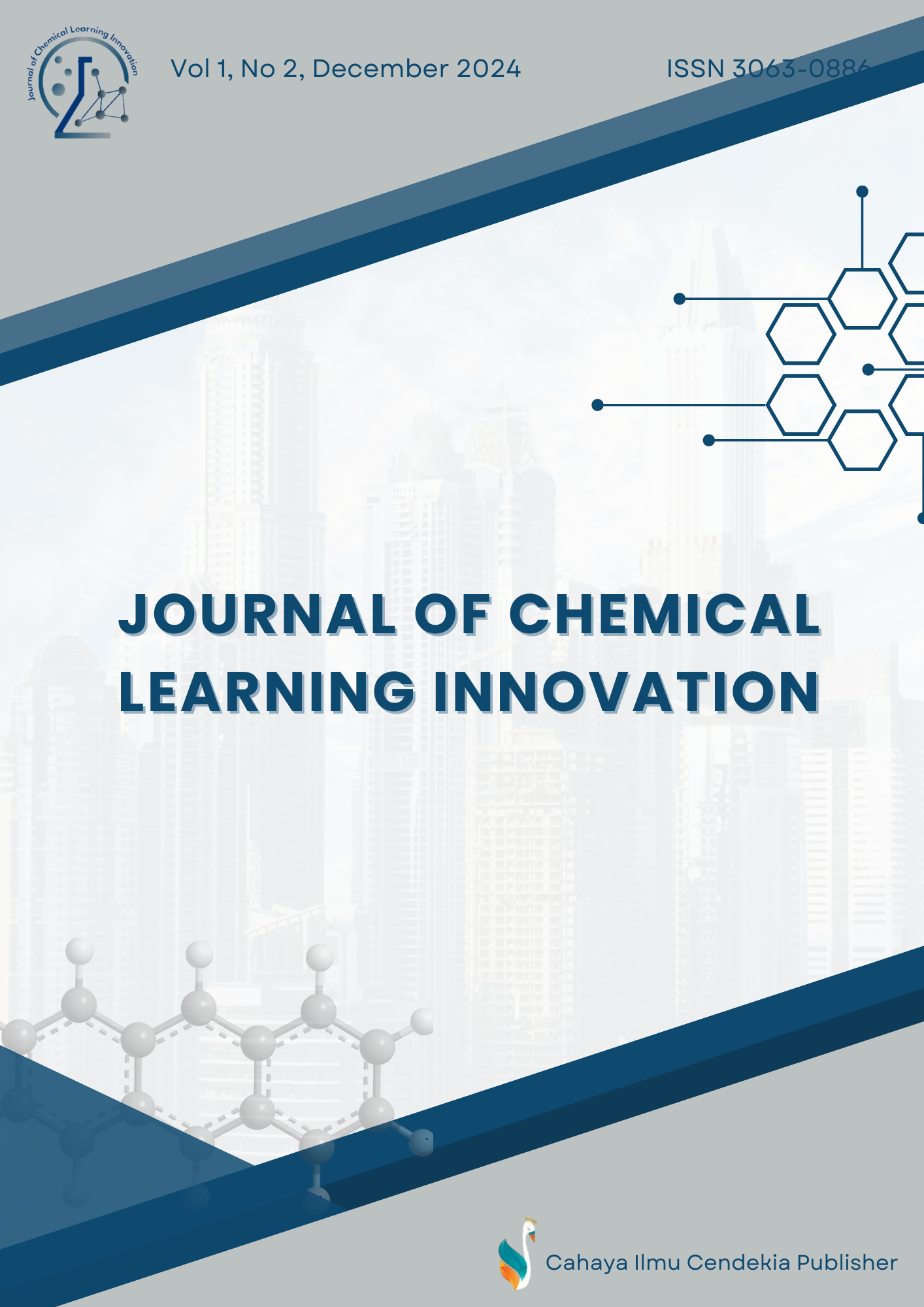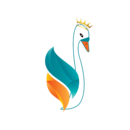Optimizing Student Activities and Learning Outcomes through Problem Solving Models in Stoichiometry Material
Abstract
Purpose of the study: This study aims to improve student activity and learning outcomes by applying the Problem Solving learning model.
Methodology: This research is a Classroom Action Research conducted in two cycles, with each cycle consisting of planning, implementation, observation and reflection. The subjects of the research were 33 students of class XC of State Senior High School 1 Wawonii. Data sources came from teachers and students. Data collection techniques were tests and non-tests (observation, document review). Data analysis used qualitative descriptive analysis techniques..
Main Findings: The results of the study showed that: Problem Solving model learning can improve student activity and learning outcomes, namely 71.00% in cycle I increasing to 85.33% in cycle II. Problem Solving model learning can improve student learning outcomes. The percentage of student learning outcome completion reached 64.63% in cycle I increasing to 81.82% in cycle II. From this study it can be concluded that the application of problem solving models can improve student activity and learning outcomes on the subject of stoichiometry.
Novelty/Originality of this study: This study offers novelty by applying the Problem Solving Model to improve student learning activities and learning outcomes in Stoichiometry material, which has been considered difficult by many students.
References
A. Astalini et al., “Identification of Student Character Values in Class X Particle Dynamics Materials,” JIPF (Jurnal Ilmu Pendidik. Fis., vol. 8, no. 3, pp. 380–388, 2023.
A. Astalini, D. Darmaji, D. A. Kurniawan, N. N. Qoidah, M. Zannah, and E. Triani, “Character Values of Tenth-Grade Students during Learning Physics in Vector Material,” JPI (Jurnal Pendidik. Indones., vol. 12, no. 1, pp. 116–123, 2023.
M. Aizinsh, S. W. Oktavia, R. Firmansyah, and R. Ruttinawati, “Exploration Of The Character Of Cooperation In Physics,” EduFisika J. Pendidik. Fis., vol. 8, no. 2, 2023.
J. P. Casquilho, F. Sinaga, N. Septiani, S. W. Oktavia, N. N. Qoidah, and E. F. S. Rini, “Pengaruh Kemampuan Berpikir Kritis Terhadap Hasil Belajar Ipa Siswa,” EduFisika J. Pendidik. Fis., vol. 8, no. 2, 2023.
F. T. Aldila, E. F. S. Rini, S. W. Octavia, H. N. Khaidah, F. P. Sinaga, and N. Septiani, “The Relationship Of Teacher Teaching Skills And Learning Interests Of Physics Students Of Senior High School: Hubungan Keterampilan Mengajar Guru Dan Minat Belajar Siswa Fisika Sma N 2 Batanghari,” EduFisika J. Pendidik. Fis., vol. 8, no. 1, pp. 101–105, 2023.
S. W. Oktavia, N. Septiani, F. Sinaga, and N. N. Qoidah, “Analysis Of The Relationship In Learning Interest To Learning Outcomes Static Fluid Material In Senior High School,” J. Ilm. Ilmu Terap. Univ. Jambi, vol. 7, no. 1, pp. 22–26, 2023, doi: https://doi.org/10.22437/jiituj.v7i1.26696.
P. R. Amnuel, F. P. Sinaga, and F. R. Winda, “Description Of Students’critical Thinking Ability Of Urban School In Physics Material,” EduFisika J. Pendidik. Fis., vol. 8, no. 2, 2023.
C. A. P. Vercaruz, N. Septiani, and R. S. Fitriani, “Comparison of Character Responsibilities and Learning Outcomes in Mexico and Indonesia in First High Schools,” EduFisika J. Pendidik. Fis., vol. 8, no. 2, pp. 183–196, 2023.
Astalini, Darmaji, D. A. Kurniawan, F. P. Sinaga, M. Z. Azzahra, and E. Triani, “Identification the 2013 Curriculum Teacher ’ s Book to Determine the Character Values of Class X Students on Circular Motion Material,” J. Pendidik. Sains Indones., vol. 11, no. 3, pp. 545–558, 2023, doi: https://doi.org/10.24815/jpsi.v11i3.28567.
N. N. Qoidah, S. Surya, and M. Hidayat, “Investigasi Metode Mengajar Guru di SMA N 2 Batanghari pada Pembelajaran Fisika,” KoPeN Konf. Pendidik. Nas., vol. 3, no. 2, pp. 138–142, 2021.
N. N. Qoidah, M. S. Zain, A. F. Adha, and E. Lawrenc, “Comparison Of Gambia And Indonesia On Digital Literacy And Learning Outcomes,” EduFisika J. Pendidik. Fis., vol. 8, no. 2, pp. 164–173, 2023.
Astalini, Darmaji, D. A. Kurniawan, S. W. Oktavia, E. Triani, and M. Z. Azzahra, “The Exploration of Character Values in Physics Learning on Momentum , Impulse , and Collision Materials,” J. Educ. Res. Eval., vol. 7, no. 2, pp. 277–284, 2023, doi: https://doi.org/10.23887/jere.v7i2.52381.
S. W. Oktavia, H. Mansyur, and M. Hidayat, “Investigasi Keterampilan Mengajar Guru Fisika SMAN 9 Kerinci,” Relativ. J. Ris. Inov. Pembelajaran Fis., vol. 6, no. 1, pp. 24–30, 2023.
F. P. Sinaga, J. Jurhana, Y. Yusrita, and M. H. M. Hidayat, “Analisis Penggunaan Metode Mengajar (Metode Demonstrasi, Metode Eksperimen, Metode Inquiry, dan Metode Discovery di SMA Negeri 11 Kota Jambi),” Relativ. J. Ris. Inov. Pembelajaran Fis., vol. 5, no. 2, pp. 103–110, 2023.
M. Yany, S. Sandi, S. Syamsuria, and H. Hamka, “Penerapan Model Pembelajaran Kooperatif Tipe Discovery Time Token Pada Mata Pelajaran IPS Ekonomi SMP Negeri 4 Watampone,” JISIP (Jurnal Ilmu Sos. dan Pendidikan), vol. 5, no. 3, 2021.
S. Saripudin, “Penggunaan Metode Pembelajaran Jigsaw Untuk Meningkatkan Prestasi Belajar Siswa,” Equilib. J. Penelit. Pendidik. dan Ekon., vol. 20, no. 02, pp. 245–256, 2023.
I. Irmawati, H. Hasnawati, M. Erdawati, and A. Asrijal, “Perbedaan Hasil Belajar Ips Ekonomi Metode Penemuan Terbimbing Setting Kooperatif Dan Metode Diskusi,” J. Rev. Pendidik. dan Pengajaran, vol. 6, no. 4, pp. 2247–2256, 2023.
I. Desiharto, D. M. Malik, and S. Qomariyah, “Peran Jigsaw Dan Problem Solving Dalam Meningkatkan Berfikir Solutif Siswa Di SD Muhammad Al-Unaizy,” Pendek. J. Pendidik. Berkarakter, vol. 1, no. 4, pp. 213–229, 2023.
M. Marzuki, “Penerapan Model Pembelajaran Problem Solving Untuk Meningkatkan Hasil Belajar Siswa Pada Materi Sistem Gerak Manusia Di Kelas Viii Sekolah Menengah Pertama Negeri 3 Sintang,” Edumedia J. Kegur. Dan Ilmu Pendidik., vol. 7, no. 2, pp. 14–25, 2023.
A. M. I. T. Asfar and S. Nur, Model pembelajaran problem posing & solving: meningkatkan kemampuan pemecahan masalah. CV Jejak (Jejak Publisher), 2018.
R. S. Ningsih and M. Mawardi, “Effectiveness of Teaching Materials to Support Merdeka Curriculum Learning on Basic Chemical Law Material on Learning Outcomes of Phase E SMA / MA,” J. Educ. Sci., vol. 8, no. 3, pp. 408–423, 2024.
L. A. Pohan, R. D. Suryanti, A. W. Nugraha, D. Pebrianti, R. Panjaitan, and S. H. Hasibuan, “Implementation Of Stem-Based Inquiry In Learning Fundamental Laws Of Chemistry: Students’ Perception And Response,” J. Pendidik. IPA Indones., vol. 13, no. 3, pp. 447–458, 2024, doi: 10.15294/jpii.v13i3.3431.
N. Sa’adah, S. Haryani, and W. Mahatmanti, “International Journal of Active Learning Analisys of Chemical Misconceptions of Stoichiometry Materials Using Certainty of Response Index,” Int. J. Act. Learn., vol. 7, no. 1, pp. 94–102, 2022, [Online]. Available: http://journal.unnes.ac.id/nju/index.php/ijal
A. Aslan, “Problem- based learning in live online classes: Learning achievement, problem-solving skill, communication skill, and interaction,” Comput. Educ., vol. 171, no. November 2020, p. 104237, 2021, doi: 10.1016/j.compedu.2021.104237.
S. Nahar, “Improving Students’ Collaboration Thinking Skill under the Implementation of the Quantum Teaching Model.,” Int. J. Instr., vol. 15, no. 3, pp. 451–464, 2022.
M. N. Tsai, Y. F. Liao, Y. L. Chang, and H. C. Chen, “A brainstorming flipped classroom approach for improving students’ learning performance, motivation, teacher-student interaction and creativity in a civics education class,” Think. Ski. Creat., vol. 38, no. September, p. 100747, 2020, doi: 10.1016/j.tsc.2020.100747.
N. Alfares, “The effect of problem-based learning on students’ problem-solving self-efficacy through blackboard system in higher education,” Int. J. Educ. Pract., vol. 9, no. 1, pp. 185–200, 2021, doi: 10.18488/journal.61.2021.91.185.200.
Y. Dai, A. Liu, and C. P. Lim, “Reconceptualizing ChatGPT and generative AI as a student-driven innovation in higher education,” Procedia CIRP, vol. 119, pp. 84–90, 2023, doi: 10.1016/j.procir.2023.05.002.
J. Kim, H. Lee, and Y. H. Cho, “Learning design to support student-AI collaboration: perspectives of leading teachers for AI in education,” Educ. Inf. Technol., vol. 27, no. 5, pp. 6069–6104, 2022, doi: 10.1007/s10639-021-10831-6.
R. R. F. Sinaga and L. Oktaviani, “the Implementation of Fun Fishing To Teach Speaking for Elementary School Students,” J. English Lang. Teach. Learn., vol. 1, no. 1, pp. 1–6, 2020, doi: 10.33365/jeltl.v1i1.245.
M. Hassan, “Online teaching challenges during COVID-19 pandemic,” Int. J. Inf. Educ. Technol., vol. 11, no. 1, pp. 41–46, 2020, doi: 10.18178/ijiet.2021.11.1.1487.
K. Ardhaoui, M. S. Lemos, and S. Silva, “Effects of new teaching approaches on motivation and achievement in higher education applied chemistry courses: A case study in Tunisia,” Educ. Chem. Eng., vol. 36, no. June, pp. 160–170, 2021, doi: 10.1016/j.ece.2021.05.004.
P. Chan, T. Van Gerven, J.-L. Dubois, and K. Bernaerts, “Virtual chemical laboratories: A systematic literature review of research, technologies and instructional design,” Comput. Educ. Open, vol. 2, p. 100053, 2021, doi: 10.1016/j.caeo.2021.100053.
P. Meesuk, B. Sramoon, and A. Wongrugsa, “Classroom Action Research-based Instruction: The Sustainable Teacher Professional Development Strategy,” J. Teach. Educ. Sustain., vol. 22, no. 1, pp. 98–110, 2020, doi: 10.2478/jtes-2020-0008.
M. Nurtanto, M. Fawaid, and H. Sofyan, “Problem Based Learning (PBL) in Industry 4.0: Improving Learning Quality through Character-Based Literacy Learning and Life Career Skill (LL-LCS),” J. Phys. Conf. Ser., vol. 1573, no. 1, pp. 0–10, 2020, doi: 10.1088/1742-6596/1573/1/012006.
E. Arent, S. Sumarmi, D. H. Utomo, and I. N. Ruja, “Improving students’ environmental care character through Positive Character Camp (PCC) program,” J. Educ. Gift. Young Sci., vol. 8, no. 4, pp. 1329–1343, 2020, doi: 10.17478/jegys.771681.
Copyright (c) 2024 Siti Jumaera, Olotu Temitope Blessing, Nyanjiga Rukondo

This work is licensed under a Creative Commons Attribution 4.0 International License.
Authors who publish with this journal agree to the following terms:
- Authors retain copyright and acknowledge that the Journal of Chemical Learning Innovation is the first publisher licensed under a Creative Commons Attribution 4.0 International License.
- Authors are able to enter into separate, additional contractual arrangements for the non-exclusive distribution of the journal's published version of the work (e.g., post it to an institutional repository or publish it in a book), with an acknowledgment of its initial publication in this journal.
- Authors are permitted and encouraged to post their work online (e.g., in institutional repositories or on their website) prior to and during the submission process, as it can lead to productive exchanges and earlier and greater citation of published work.





.png)
.png)










